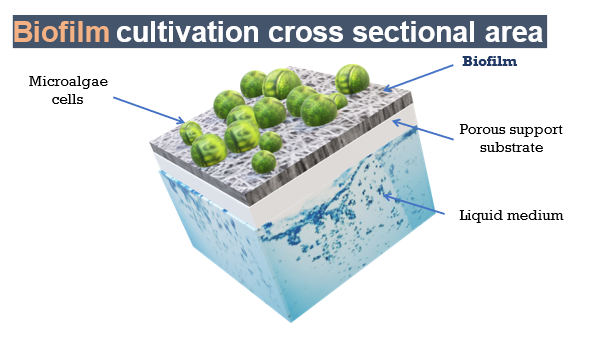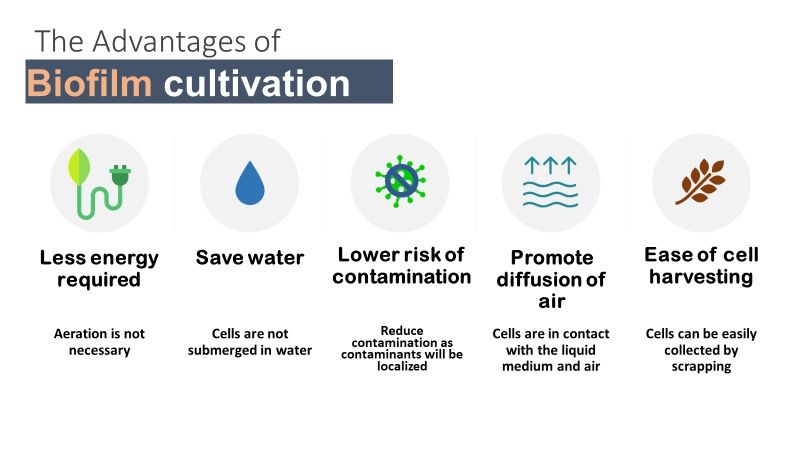Bio-coating for Attached Microalgae Growth

Assoc. Prof. Dr. Derek Chan Juinn Chieh
Miss Cheah Yi Tong
Microalgae, unicellular microorganisms which utilize natural sunlight for carbon bio-fixation are exploited for the production of wide spectrum of value-added organic compounds in industrial setting. Instead of employing conventional cultivation means (open pond systems, tubular photo-bioreactors etc.), researchers recently shed light on microalgal biofilm cultivation to cut down substantial land and water footprint, as well as energy input that is necessary to harvest the micron-size cells. Unfortunately, biofilm development is easily hampered by nutrient limitation or light irradiation constraint, hence causing biofilm rupture or biomass wash off. Hence, this project initiates a new approach to reinforce both the cell adhesion and biofilm cohesion towards the selected carriers by pre-depositing a thin layer of bio-coating on the surface of supporting materials prior to any biofilm culture. These bio-coatings could serve as an artificial stabilizer to concentrate and immobilize the microalgal cells, giving rise to a new eco-friendly strategy with scalable cultivation footprint and a balanced environmental risk. It was also in line with the United Nations’s Sustainable Development Goals with potential towards the contribution of Zero Hunger, Clean Water and Sanitation, Affordable and Clean Energy, and Responsible Consumption and Production.
Problem Statement
Conventional liquid microalgae cultivation.
- Not economically competitive - particularly for bioproducts with a large market volume but low value (e.g., biofuel vs fossil fuel).
- Lower growth rates.
- Contamination with less productive species.
- Poor harvesting efficiency.
- High energy consumption.
- High water requirement.
Novelty and Inventiveness
Attached microalgae growth benefits from:
- Natural bio-coating used is not detrimental to microalgae growth.
- Save up to 80% water consumption for growing microalgae.
- Save energy consumption as aeration is not required.
- Contamination risk is limited.
- Promote rapid diffusion of CO2/O2 to the cells.
- Ease of harvesting via scrapping, no chemical agents needed.
- Water in microalgae cells will contain lesser water content.
Applicability and Benefits
- Suitable for large scale microalgae cultivation.
- Reduces water and energy consumption.
- Facilitate microalgae biomass harvesting via mechanical means (scrapping).
Research Achievement
Grant: Role of algal organic matter in microalgae adhesion to solid surfaces by Ministry of Higher Education, Malaysia, January 2019 to September 2022, RM114,500.
Commercialization Potential And Industrial Partner
- The potential to grow microalgae with much lower water and energy consumption coupled with easy harvesting step as compared to conventional suspension culture.
- Applicable to most microalgae cultivation system.
Intellectual Property Status
In Progress.
Status of Invention
Technology Readiness Level 3.
Impact of Innovation
- Academic: New concept is going to be established with this proposed project. Bio-coating developed could serve as a novel culture platform for mass cultivation of microalgae and deserves more in-depth studies in future.
- Industry: Successful establishment of a stable bio-coating would serve as a paradigm shift for conventional cultivation means. Stronger biofilm-based cultivation eventually minimizes total production, operating cost and biomass harvesting cost.
- Environment: Stable microalgal biofilm on bio-coated carriers would substantially enhance the performance in wastewater remediation and carbon dioxide capture.
- Society: Mass cultivation of sustainable and renewable energy resources in biofilm type would benefit human food supply and energy needs.
- Government: The government would be able to achieve a more cost-effective renewable energy production from microalgae which in return a cheaper alternative fuel. A renewable and sustainable energy mix policy could be achieved by 2025-2030.


